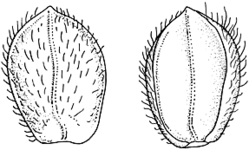Common name: Russell River Grass
Paspalum paniculatum L. APNI* 
Description: Perennials to c. 1.6 m tall, sometimes with rhizomes covered with hirsute cataphyll or their remains.
Ligule c. 1 mm long; blade 8–19 mm wide, the indumentum of young leaves rather soft and dense.
Inflorescence crowded, ultimately open and wide-ovate, to 20 cm wide, 7–20 cm long, consisting of 10–30 scattered or irregularly approximate racemes at first erect but at length spreading; racemes slender, dense, 4- or, by partial abortion, 2-ranked, to 10 cm long. Spikelets imbricate, circular-elliptic in outline, almost hemispheric, obtuse or subapiculate, 1.25–1.5 mm. Lower glume absent. Upper glume the size and shape of the spikelet, very convex, thinly membranous to papery, pubescent, 3-nerved; lower lemma more or less flat, similar to the upper glume. Upper lemma as long as the lower, similar in outline but obtuse, the lemma and palea firmly papery to crustaceous, pale; palea with widely auricled flaps.
Flowering: Summer.
Distribution and occurrence: Native of tropical America. A naturalised pasture species.
NSW subdivisions: *NC, *NWS
Other Australian states: *Qld
Text by Jacobs, S.W.L., Whalley, R.D.B. & Wheeler, D.J.B.
Taxon concept: Grasses of New South Wales, Fourth Edition (2008).
APNI* Provides a link to the Australian Plant Name Index (hosted by the Australian National Botanic Gardens) for comprehensive bibliographic data
***The AVH map option provides a detailed interactive Australia wide distribution map drawn from collections held by all major Australian herbaria participating in the Australian Virtual Herbarium project.
|


